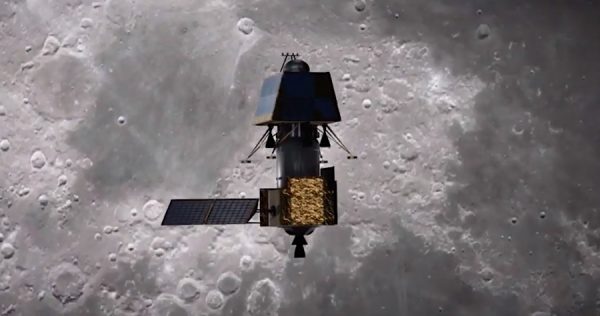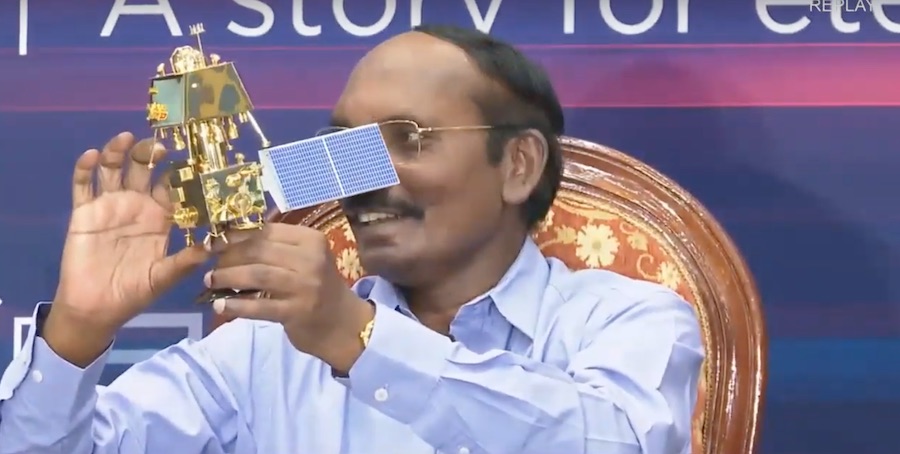Chandrayaan 2 arrives in lunar orbit, targets moon landing next month – Spaceflight Now

India’s Chandrayaan 2 spacecraft braked into orbit around the moon Tuesday, positioning the robotic science mission for a landing in the moon’s south pole region Sept. 6.
The spacecraft ignited its main engine at 0332 GMT Tuesday (11:32 p.m. EDT Monday) and fired for 29 minutes to reduce the the probe’s velocity by more than 600 mph (300 meters per second), allowing the moon’s gravity to capture Chandrayaan 2 into orbit.
The make-or-break rocket burn sets up Chandrayaan 2 for a series of burns to adjust its orbit over the next two weeks before the separation of the mission’s orbiter and lander elements Sept. 2, ahead of the lander’s final descent maneuver.
“Today, the Chandrayaan 2 mission crossed a major milestone,” said K. Sivan, chairman of the Indian Space Research Organization, India’s space agency.
Sivan said the 29-minute engine firing Tuesday “precisely injected” the Chandrayaan 2 spacecraft into the planned orbit around the moon.
Chandrayaan 2 became the second Indian spacecraft to orbit the moon after India’s Chandrayaan 1 orbiter, which arrived in 2008 and made history by detecting water-bearing molecules at the lunar poles, with the highest concentrations inside permanently-shadowed craters at the south pole.
Tuesday’s lunar orbit insertion maneuver placed the Chandrayaan 2 spacecraft in an elliptical orbit around the moon, with an altitude ranging from 70 miles (114 kilometers) at its lowest point, to a high point of 11,229 miles (18,072 kilometers), according to ISRO.
If Tuesday’s burn was unsuccessful, Chandrayaan 2 would have missed the moon and the mission would have been lost, Sivan said.
Less than half of the attempts to land on the moon since the dawn of the Space Age have been successful, and the $142 million Chandrayaan 2 mission will be India’s first try.
“Even though we got a successful lunar orbit insertion today, still the landing is a terrifying moment,” Sivan said. “Until now, (many of) our lunar lander systems have not operated, especially the propulsion system. That will come only after the 2nd (of September). Only then we will know.
“That is a phase we are doing for the first time,” Sivan said. “Whereas today’s lunar orbit insertion … we’ve already done that once.”
But Sivan said he is confident Chandrayaan 2 will safely land.
“One good thing is we are learning from their failures,” he said.
“We have the confidence in this landing mission,” Sivan said. “We are confident because we have enough testing, enough simulations. All the subsystem- and system-level, sensor-level, thruster-level, all the simulations here are done. We are confident that anything humanly possible, we did.”

Chandrayaan 2 launched July 22 aboard India’s largest rocket, the GSLV Mk.3, into an egg-shaped orbit around Earth.
The spacecraft gradually boosted its orbit to higher latitudes with a series of five engine burns, culminating with a trans-lunar injection maneuver Aug. 13 (GMT) to place Chandrayaan 2 on a trajectory to intercept the moon.
With Chandrayaan 2 now in a stable orbit around the moon, ISRO ground teams will oversee a further sequence of burns using the orbiter’s propulsion system to guide the spacecraft into a circular 62-mile-high (100-kilometer) orbit. The lunar orbit maneuvers will begin with an engine firing Wednesday, followed by additional firings Aug. 28, Aug. 30 and Sept. 1.
“The next major event happens on the 2nd of September, when the lander will be separated from the orbiter,” Sivan said. “Until now, the entire operations are carried out by the propulsion systems from the orbiter. From Sept. 2 onwards, the entire attention will be on the lander.”
The landing module is named Vikram for Vikram Sarabhai, the father of India’s space program, and after touchdown will deploy the Pragyan rover, named for the Sanskrit word for “wisdom.”
After separating from the orbiter, the Vikram lander will conduct a test burn of its propulsion system Sept. 3.
“After confirming the normalcy of the system, then on the 4th of September, we will be doing the real deorbit maneuver for the lander for about 6.5 seconds,” Sivan said. “In that maneuver, the lander will be put into an orbit with 35 kilometers (21 miles) perilune and about 97 kilometers (60 miles) apolune.”
“For the next (few) days, we’ll be checking the various parameters of the lander to ensure everything is right,” Sivan said.
The final 15-minute powered descent sequence will set up for touchdown in an ancient polar highlands region between two craters at approximately 70.9 degrees south latitude, and 22.8 degrees east longitude, closer to the moon’s south pole than any previous mission.
Five throttleable liquid-fueled engines will control the lander’s rate of descent, and a laser rangefinder will guide the spacecraft toward the landing zone. After the start of the powered descent phase, the entire landing sequence will be autonomous, without input from ground controllers.
Landing is scheduled for around 2125 GMT (5:25 p.m. EDT) on Sept. 6, according to Sivan.
The 59-pound (27-kilogram) Pragyan rover is expected to drive off the lander around four hours after touchdown to begin driving across the lunar surface. Pragyan carries a suite of instruments to study the composition of rocks and soil at the landing site.
The Vikram lander, meanwhile, will take panoramic images, measure seismic activity and extend a probe to a depth of up to 4 inches (10 centimeters) to collect data on underground thermal conductivity. A NASA-provided laser retroreflector is also flying on the Vikram lander.
Chandrayaan 2’s stationary lander and rover are designed to last at least 14 days — equivalent to half of a lunar day — until the sun sets at the landing site, robbing the vehicles of electrical power as temperatures plummet to near minus 300 degrees Fahrenheit (minus 183 degrees Celsius).
Sivan said Tuesday that the frigid temperatures could damage sensitive components inside the lander and rover.
“At that temperature, we are qualified, but I cannot give confidence to you (that the spacecraft will survive,” Sivan said. “It may happen. It may not happen.”
If Chandrayaan 2’s landing is successful, India will become the fourth nation to accomplish a controlled soft touchdown on the moon, following landings by the Soviet Union, the United States and China.
Meanwhile, the Chandrayaan 2 orbiter will conduct its own scientific observations over a mission scheduled to last at least one year. The orbiter will take high-resolution images and scan the lunar surface with radar and spectral imagers to hunt for signs of water ice.
Reservoirs of frozen water on the moon could be converted into rocket fuel and other supplies for a lunar base.
NASA’s Artemis program aims to land a two-person crew near the moon’s south pole by 2024, and Sivan said findings by missions like Chandrayaan 2 will provide important data for teams planning a human anding.
“We are are going to land near the south pole, and Artemis is also going to land a man near the south pole,” Sivan said. “I’m sure that this will give a lot of input to them, but what input it will give, don’t ask me now. After the science, I can tell you.”
Email the author.
Follow Stephen Clark on Twitter: @StephenClark1.






